Stretching can be a powerful tool to ease anxiety and calm your mind. You can start with Child's Pose, which activates your body's relaxation response. Forward Folds and Legs Up the Wall help release tension in your back and legs. Try Cat-Cow and Neck Rolls to promote breath awareness and relieve upper body stress. Pigeon Pose and Supine Twists target hip and spine tension, while Chest-Opening stretches encourage deeper breathing. Don't forget Progressive Muscle Relaxation to identify and release overall body tension. These simple yet effective stretches can become your go-to anxiety relief toolkit, offering both immediate and long-term benefits.
Key Takeaways
- Child's Pose calms the mind and body, activating the parasympathetic nervous system to counteract anxiety.
- Legs Up the Wall reduces stress by calming the nervous system and improving circulation.
- Forward Fold releases tension in the back, neck, and shoulders, promoting calmness and easing anxiety.
- Cat-Cow promotes breath awareness and mindfulness, helping to shift focus away from anxious thoughts.
- Progressive Muscle Relaxation Technique increases awareness of muscle tension and promotes overall relaxation.
Child's Pose for Calming
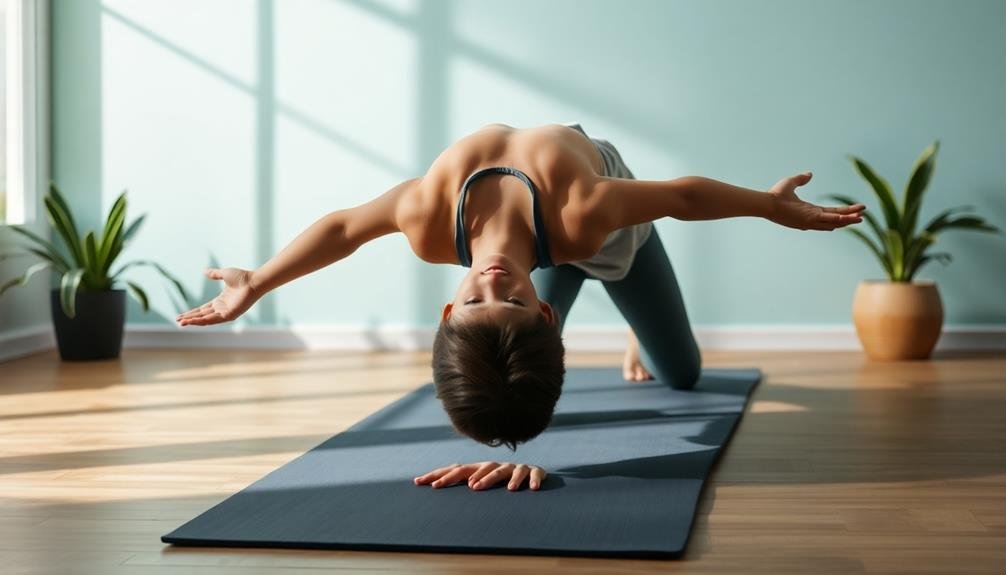
The Child's Pose is a gentle, restorative stretch that can help calm your mind and body during anxious moments. To perform this pose, kneel on the floor with your big toes touching and your knees hip-width apart. Sit back on your heels and fold forward, extending your arms in front of you. Rest your forehead on the mat and breathe deeply.
As you hold this position, focus on your breath and let tension melt away from your back, shoulders, and neck. You'll feel a gentle stretch in your hips, thighs, and ankles. This pose encourages relaxation by activating your parasympathetic nervous system, which helps counteract the fight-or-flight response associated with anxiety.
To enhance the calming effects, try incorporating slow, controlled breathing. Inhale for a count of four, hold for four, then exhale for four. Repeat this breathing pattern for 5-10 minutes while maintaining the pose.
If you find it uncomfortable to rest your forehead on the floor, place a cushion or folded blanket under your head for support. Remember, you can always modify the pose to suit your body's needs and comfort level.
Forward Fold to Release Tension
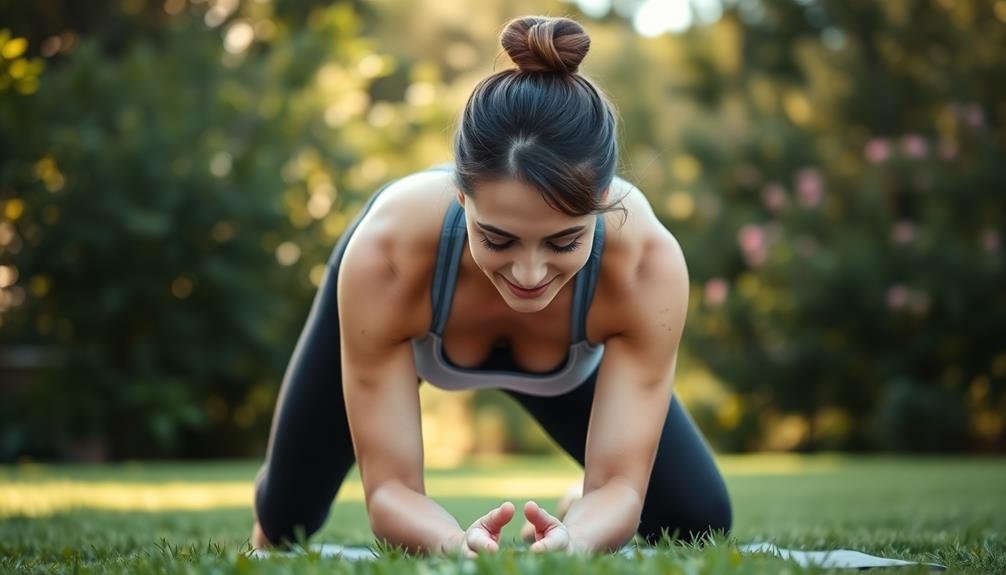
You'll find the Forward Fold an excellent stretch for releasing tension and easing anxiety.
To perform it correctly, stand with your feet hip-width apart, then slowly bend forward from your hips, allowing your upper body to hang loosely.
As you hold this position, you'll feel a gradual release of stress in your back, neck, and shoulders, promoting a sense of calm throughout your body.
Proper Forward Fold Technique
Tension melts away as you sink into a proper forward fold. This posture targets your hamstrings, lower back, and shoulders, effectively releasing built-up stress.
To perform a forward fold correctly, start by standing with your feet hip-width apart. Take a deep breath, then exhale as you hinge at your hips, keeping your back straight. Let your upper body drape over your legs, allowing gravity to do the work.
For maximum benefit, follow these key steps:
- Keep your knees slightly bent to protect your lower back
- Let your head hang heavy, releasing tension in your neck
- Grab opposite elbows with your hands, creating a gentle sway
- Hold the position for 30 seconds to 1 minute, breathing deeply
Don't force yourself to touch the ground; instead, focus on the stretch in your hamstrings and the lengthening of your spine.
If you can't reach your toes, use yoga blocks or rest your hands on your shins. Remember, it's not about how far you can fold, but how effectively you're releasing tension and calming your mind.
Benefits for Anxiety Relief
Forward folds offer more than just physical flexibility; they're powerful tools for anxiety relief. When you perform a forward fold, you're fundamentally sending a calming signal to your nervous system. This posture activates the parasympathetic nervous system, which is responsible for the "rest and digest" response in your body. As a result, you'll likely experience a decrease in heart rate and blood pressure, promoting a sense of calm and relaxation.
The gentle inversion of a forward fold also increases blood flow to your brain, potentially improving cognitive function and mood. As you hang your head below your heart, you're encouraging fresh, oxygenated blood to circulate through your brain cells. This can help clear your mind and reduce racing thoughts associated with anxiety.
Moreover, forward folds stretch the muscles along your spine and the back of your legs, areas where tension often accumulates due to stress. By releasing this physical tension, you're also releasing emotional tension.
The act of folding forward and letting go can be symbolically powerful, helping you release worries and anxious thoughts. Regular practice of forward folds can lead to long-term improvements in stress management and overall emotional well-being.
Cat-Cow for Breath Awareness
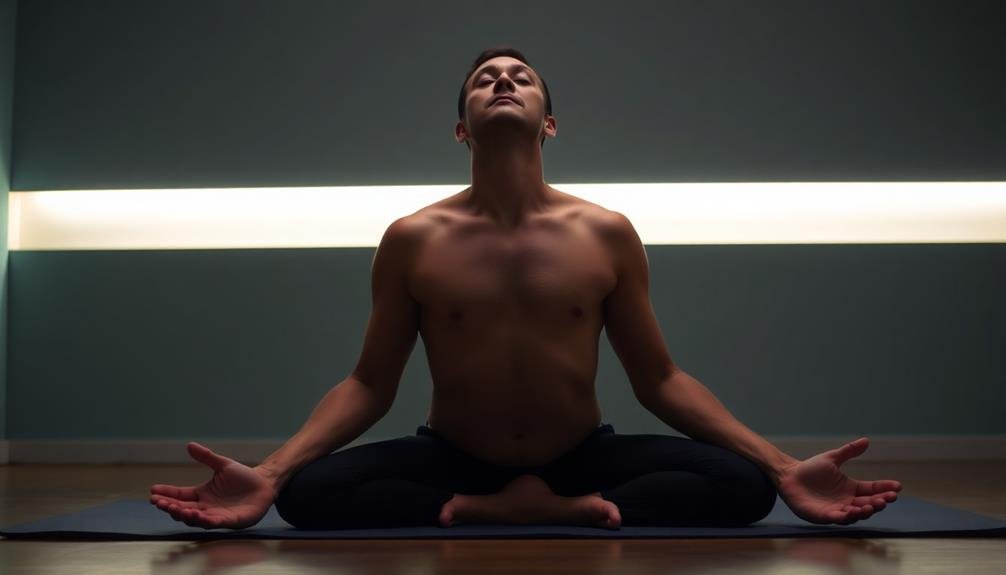
While many yoga poses can help alleviate anxiety, the Cat-Cow stretch is particularly effective for promoting breath awareness. This gentle, flowing movement between two poses encourages you to focus on your breath, which can help calm your mind and reduce anxiety symptoms.
To perform the Cat-Cow stretch:
- Start on your hands and knees, with your wrists aligned under your shoulders and knees under your hips.
- As you inhale, drop your belly towards the mat, lift your chest and chin, and gaze upward (Cow pose).
- As you exhale, round your spine towards the ceiling, tuck your chin to your chest, and draw your navel in (Cat pose).
- Continue alternating between these positions, syncing your breath with each movement.
As you practice this stretch, pay close attention to your breath and how it corresponds with each movement. This mindful awareness can help shift your focus away from anxious thoughts and into the present moment.
The rhythmic nature of the Cat-Cow stretch also promotes relaxation and can help release tension in your spine and abdomen, further contributing to anxiety relief.
Neck and Shoulder Rolls
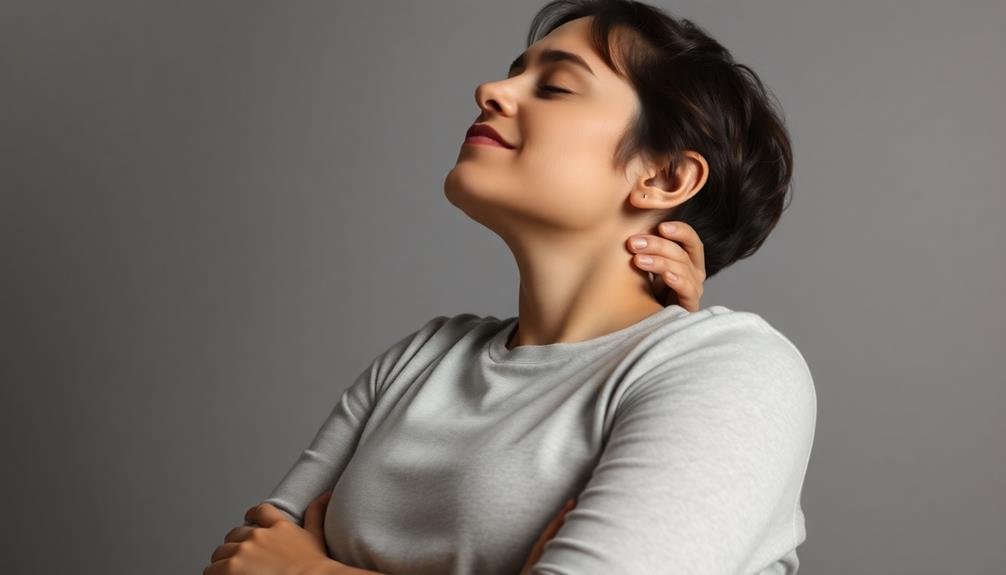
Neck and shoulder rolls can greatly reduce tension in areas where anxiety often manifests physically.
You'll find relief by gently rolling your head in circles and shrugging your shoulders up and down.
To perform these stretches effectively, maintain a relaxed posture and breathe deeply, allowing each movement to release built-up stress.
Benefits for Stress Relief
Throughout the day, tension often accumulates in your neck and shoulders, leading to increased stress and anxiety. Performing neck and shoulder rolls can provide significant benefits for stress relief. These simple exercises help release built-up tension, improve circulation, and promote relaxation in your upper body.
When you practice neck and shoulder rolls regularly, you'll experience:
- Reduced muscle tightness: The rolling motion helps loosen tight muscles, alleviating discomfort and promoting a sense of ease.
- Improved range of motion: As you stretch and roll your neck and shoulders, you'll increase flexibility and mobility in these areas.
- Enhanced blood flow: The gentle movement stimulates circulation, bringing oxygen and nutrients to your muscles and brain.
- Mental clarity: By focusing on the physical sensation of the rolls, you'll momentarily shift your attention away from stressors, promoting a calmer state of mind.
To maximize the stress-relieving benefits, perform neck and shoulder rolls slowly and mindfully. Pay attention to your breath, inhaling deeply as you roll your shoulders back and exhaling as you roll them forward.
Similarly, breathe slowly and intentionally as you gently roll your neck from side to side and front to back.
Technique and Proper Form
To perform neck and shoulder rolls correctly, you'll need to focus on proper technique and form. Start by standing or sitting with your back straight and shoulders relaxed.
For neck rolls, gently lower your chin to your chest, then slowly rotate your head clockwise, making a complete circle. As you roll, keep your movements smooth and controlled, avoiding any jerky motions. Repeat the process counterclockwise.
For shoulder rolls, begin by raising your shoulders towards your ears, then roll them backwards in a circular motion. Imagine drawing large circles with your shoulder blades. After a few repetitions, reverse the direction and roll your shoulders forward.
Throughout both exercises, breathe deeply and steadily. Inhale as you lift or rotate, and exhale as you lower or complete the circle. If you experience any pain or discomfort, stop immediately and consult a healthcare professional.
Perform these stretches slowly and mindfully, focusing on the sensation in your muscles. Aim for 5-10 repetitions in each direction for both neck and shoulder rolls.
Legs Up the Wall
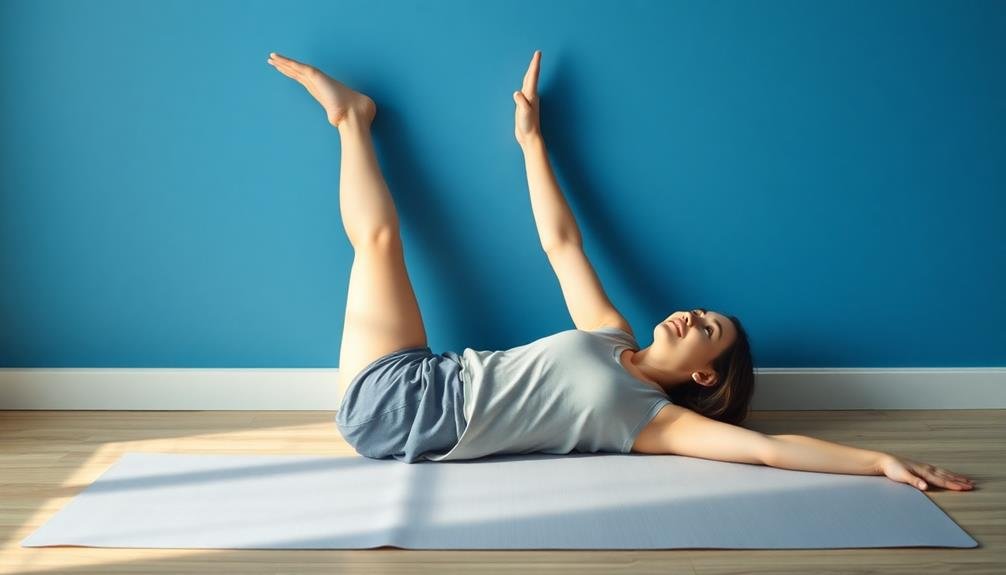
This simple yet effective pose can work wonders for reducing anxiety and promoting relaxation. To perform the Legs Up the Wall stretch, find a clear wall space and lie on your back with your buttocks as close to the wall as possible.
Gently lift your legs and rest them against the wall, forming an L-shape with your body. Allow your arms to rest comfortably by your sides, palms facing up. Close your eyes and focus on your breath, letting tension melt away from your body.
Here are four key benefits of this stretch:
- Reduces stress and anxiety by calming the nervous system
- Improves circulation and lymphatic flow
- Relieves lower back pain and tension
- Helps alleviate headaches and migraines
You'll want to hold this pose for 5-15 minutes, depending on your comfort level. If you experience any discomfort in your lower back, place a folded blanket or pillow under your hips for support.
As you practice this stretch regularly, you'll likely notice a significant reduction in anxiety symptoms and an overall sense of calm and well-being.
Seated Spinal Twist
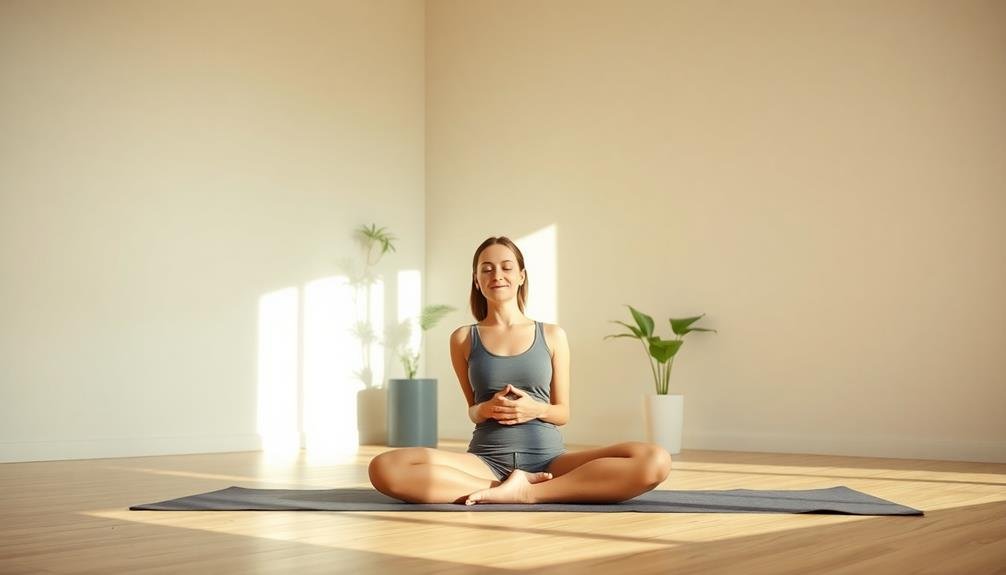
While sitting comfortably on the floor, you can perform a Seated Spinal Twist to release tension and anxiety stored in your back and abdomen.
Start by extending your legs straight out in front of you. Bend your right knee and place your right foot on the outside of your left thigh. Keep your left leg extended.
Place your right hand on the floor behind you for support. Inhale deeply, then exhale as you twist your torso to the right. Bring your left arm to the outside of your right knee, using it as leverage to deepen the twist. Keep your spine long and your shoulders relaxed.
As you hold this position, focus on your breath. With each inhale, lengthen your spine. With each exhale, gently twist a bit further. Hold the pose for 30 seconds to one minute, feeling the stretch in your back, shoulders, and hips.
This twist can help massage your internal organs, improving digestion and reducing stress.
After releasing the twist, slowly return to center. Repeat the stretch on the opposite side to balance your body. You'll likely feel a sense of release and calm after completing this stretch.
Butterfly Stretch for Grounding
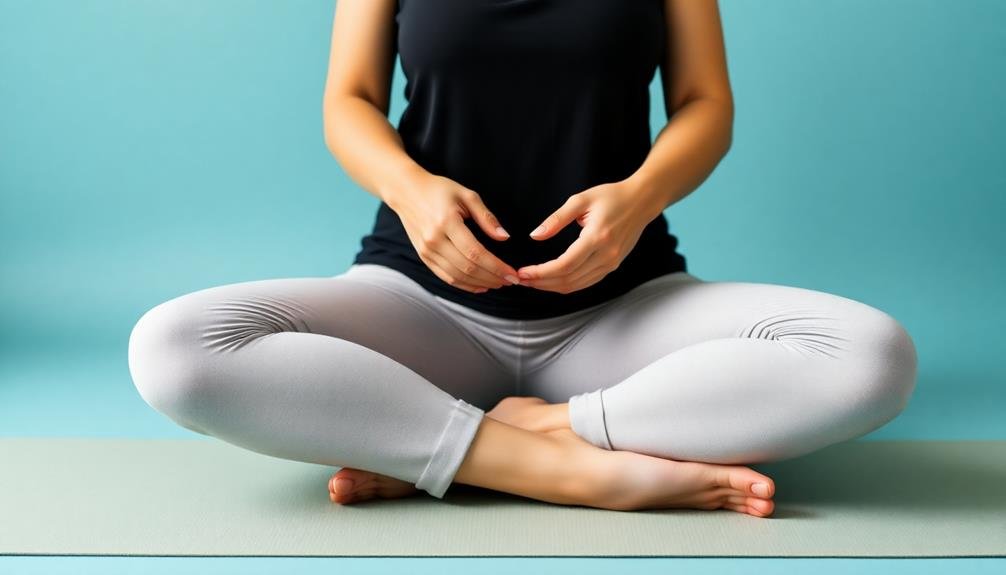
A gentle butterfly pose can help you feel grounded and centered while releasing tension in your hips and lower back. This stretch is particularly effective for anxiety relief as it encourages deep breathing and promotes a sense of calm. To perform the butterfly stretch, sit on the floor with your back straight and bring the soles of your feet together, allowing your knees to fall outward.
To maximize the benefits of this grounding exercise, follow these steps:
- Place your hands on your ankles or feet, gently pressing them together.
- Inhale deeply, lengthening your spine and lifting your chest.
- As you exhale, slowly fold forward from your hips, keeping your back straight.
- Hold the position for 30 seconds to 1 minute, focusing on your breath.
As you practice the butterfly stretch, you'll notice a gradual release of tension in your inner thighs and hips. This opening of the lower body can help alleviate anxiety by promoting better circulation and reducing muscle tightness.
Remember to breathe slowly and deeply throughout the stretch, allowing each exhale to release any built-up stress or worry. If you feel any discomfort, ease back slightly and listen to your body's limits.
Standing Quad Stretch
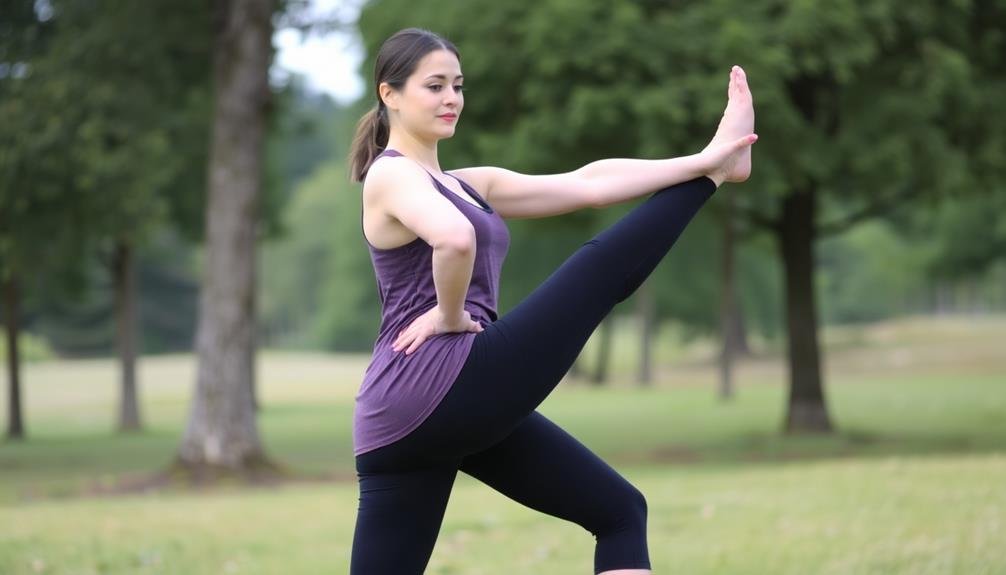
The standing quad stretch targets the large muscles in your thighs, helping release tension that's often held there during times of stress.
You'll feel an immediate release as you gently pull your foot towards your buttocks, maintaining balance and proper alignment.
This stretch can be modified for different fitness levels and can be particularly effective when combined with deep breathing techniques to enhance its anxiety-relieving benefits.
Proper Form and Technique
Mastering proper form and technique for the standing quad stretch is essential to maximize its anxiety-relieving benefits. When performing this stretch, you'll want to focus on maintaining balance and proper alignment to guarantee you're targeting the right muscles and avoiding potential injury.
To execute the standing quad stretch correctly:
- Stand tall with your feet hip-width apart and engage your core.
- Bend your right knee, bringing your heel towards your buttocks.
- Grasp your right foot with your right hand, keeping your knees close together.
- Gently pull your heel closer to your body, feeling the stretch in your quadriceps.
As you hold the stretch, keep your standing leg slightly bent to avoid locking your knee. Maintain a straight spine and avoid arching your back or leaning forward.
If you're struggling with balance, use your free hand to hold onto a wall or chair for support. Remember to breathe deeply and evenly throughout the stretch, holding for 15-30 seconds before switching sides.
Benefits for Anxiety Relief
Several key benefits make the standing quad stretch an excellent choice for anxiety relief. This stretch targets large muscle groups in your legs, which can hold tension when you're feeling anxious. By releasing this tension, you'll experience a physical sense of relaxation that can help calm your mind.
The standing quad stretch also improves your balance and body awareness. As you focus on maintaining your posture and breathing during the stretch, you'll naturally shift your attention away from anxious thoughts. This mindfulness aspect can help ground you in the present moment, reducing worry about the future or past.
You'll also benefit from increased blood flow to your muscles and brain. This improved circulation can help clear your mind and boost your mood. The stretch's simplicity means you can do it almost anywhere, giving you a quick tool to manage anxiety in various situations.
Regularly practicing the standing quad stretch can lead to long-term flexibility improvements. This increased flexibility may help you feel more comfortable in your body, potentially reducing physical symptoms of anxiety like muscle tension and restlessness.
Variations and Modifications
While the basic standing quad stretch offers numerous benefits, you can spice it up with variations to suit your needs and abilities. These modifications can help you target different muscle groups, increase the stretch's intensity, or make it more accessible if you're dealing with balance issues or injuries.
Here are four variations of the standing quad stretch you can try:
- Wall-supported quad stretch: Lean against a wall for added stability while performing the stretch.
- Lying quad stretch: Lie on your side and pull your top foot towards your buttocks for a gentler version.
- Dynamic quad stretch: Alternate between holding the stretch and releasing it in a rhythmic motion.
- Yoga-inspired variation: Incorporate the quad stretch into a warrior III pose for a full-body challenge.
Remember to listen to your body and adjust the intensity as needed.
If you're new to stretching or have any existing health conditions, it's best to consult with a healthcare professional before trying new variations.
Pigeon Pose for Hip Release
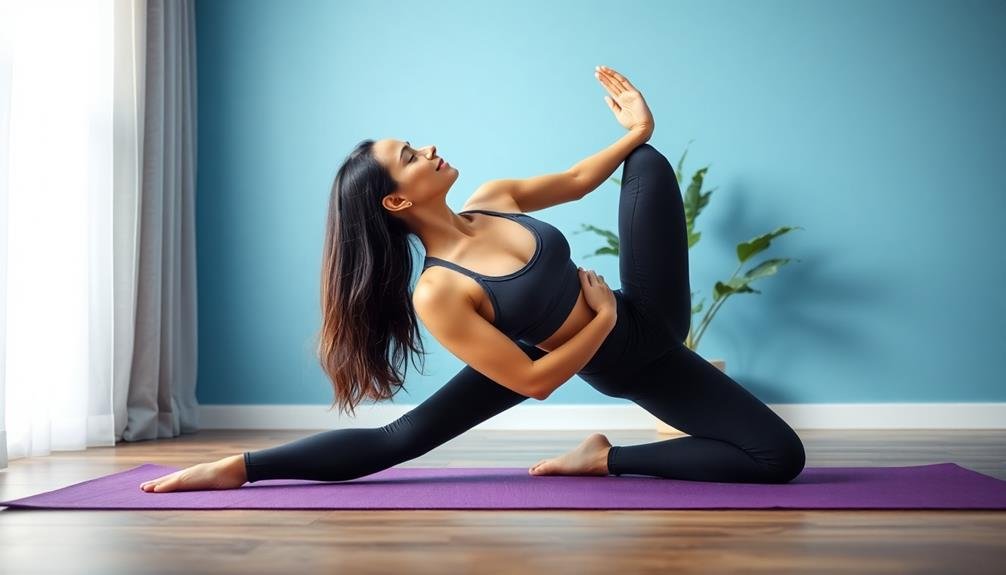
The Pigeon Pose is a powerful hip-opening stretch that can help release tension and reduce anxiety.
To perform this pose, start in a tabletop position on your hands and knees. Bring your right knee forward and place it behind your right wrist. Slide your right ankle towards your left hip, keeping your left leg extended behind you. Lower your hips and lengthen your spine, placing your hands on either side of your hips for support.
As you hold the pose, focus on breathing deeply and relaxing your hips. You'll likely feel a stretch in your right hip and possibly your left hip flexor. If you're experiencing discomfort in your knee, adjust your position or place a folded blanket under your hip for support.
To deepen the stretch, you can fold forward over your bent leg, resting your forearms on the floor. Hold the pose for 30 seconds to a minute, then slowly release and switch sides.
Remember to move gently and listen to your body. If you have any hip or knee injuries, consult with a healthcare professional before attempting this pose.
Chest-Opening Doorway Stretch
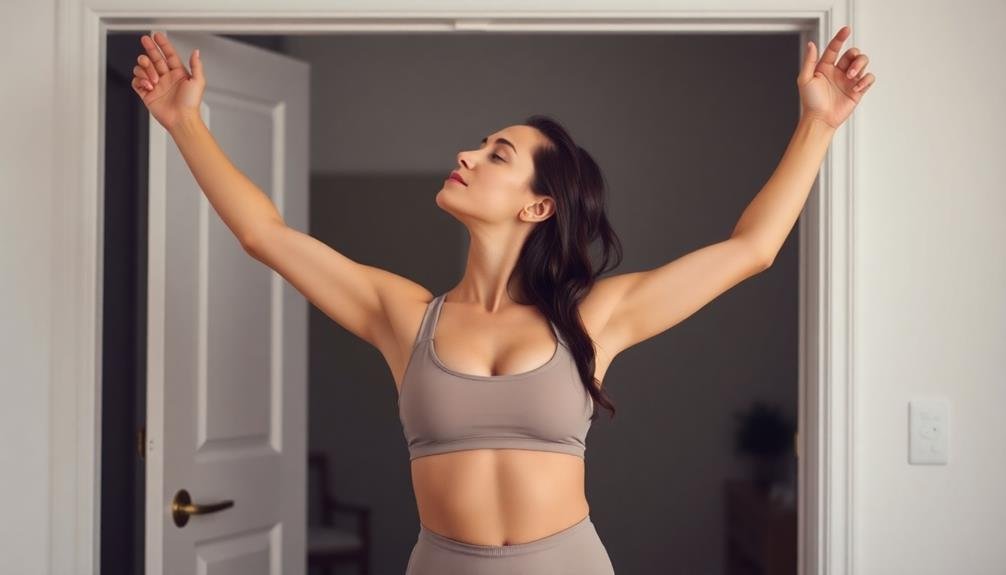
Moving from hip-opening to chest-opening exercises, let's explore the Chest-Opening Doorway Stretch. This simple yet effective stretch can help alleviate anxiety by releasing tension in your chest, shoulders, and upper back. You'll need a doorway to perform this stretch properly.
To do the Chest-Opening Doorway Stretch:
- Stand in an open doorway with your feet hip-width apart.
- Raise your arms to shoulder height and place your palms on either side of the doorframe.
- Step one foot forward, keeping your back straight and core engaged.
- Lean forward slightly, feeling the stretch across your chest and shoulders.
Hold this position for 15-30 seconds, breathing deeply and steadily. You'll feel your chest expand as you inhale, intensifying the stretch.
This exercise can help counteract the effects of poor posture, which often contributes to feelings of anxiety and stress. By opening your chest, you're encouraging deeper breathing and promoting a sense of calm.
Perform this stretch several times throughout the day, especially if you spend long hours sitting at a desk or hunched over electronic devices. It's a quick and easy way to reset your posture and mindset.
Supine Twist for Spine Relief
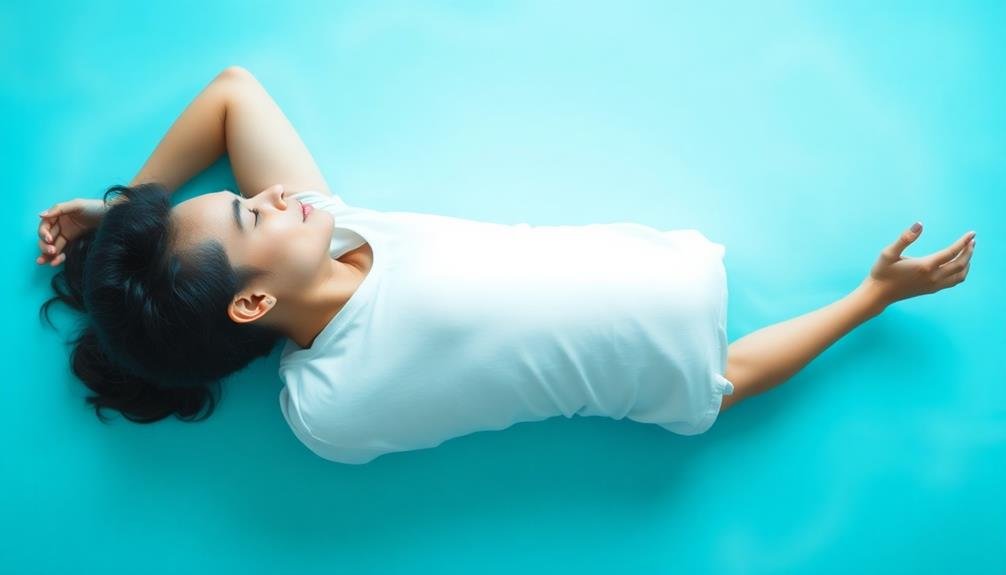
After opening your chest, it's time to focus on releasing tension in your spine with the Supine Twist. This gentle stretch can help alleviate anxiety by promoting relaxation throughout your back and core.
Lie on your back with your knees bent and feet flat on the floor. Extend your arms out to the sides, forming a T-shape. Slowly lower both knees to the right side of your body, keeping your shoulders pressed firmly against the ground. Turn your head to the left, gazing in the opposite direction of your knees. Hold this position for 30 seconds to 1 minute, breathing deeply.
As you hold the twist, you'll feel a stretch along your spine, lower back, and obliques. This position helps release built-up tension and promotes better spinal mobility. The twisting motion can also stimulate digestion, which is often affected by anxiety.
To come out of the pose, engage your core and slowly bring your knees back to center. Repeat the twist on the opposite side to maintain balance. Perform this stretch 2-3 times on each side for maximum benefit.
Remember to move slowly and mindfully, never forcing your body beyond its limits.
Progressive Muscle Relaxation Technique
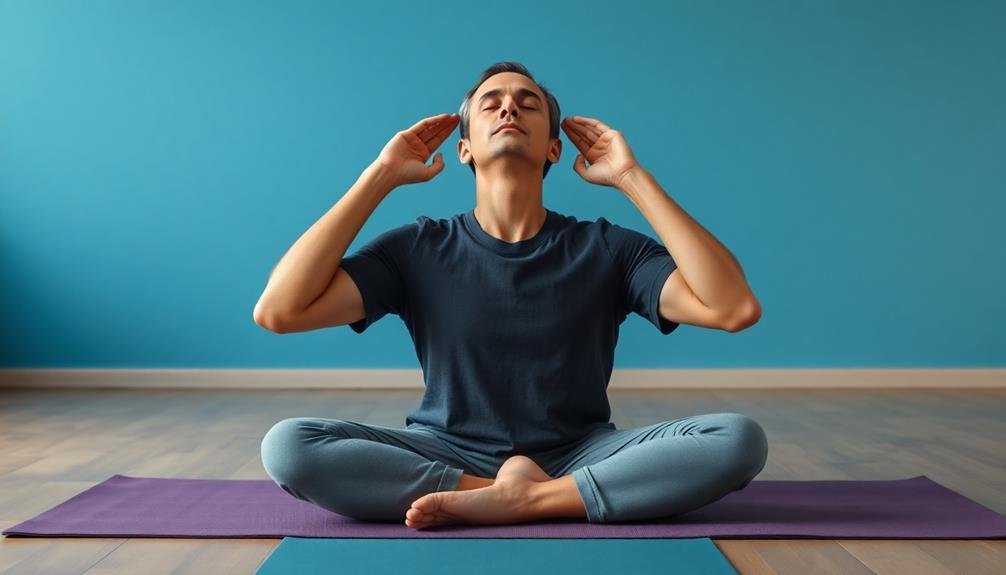
One powerful technique to combat anxiety is progressive muscle relaxation. This method involves systematically tensing and then releasing different muscle groups throughout your body. By focusing on the physical sensations of tension and relaxation, you'll shift your attention away from anxious thoughts and promote a sense of calm.
To practice progressive muscle relaxation, find a quiet, comfortable space where you won't be disturbed. Lie down or sit in a relaxed position, and follow these steps:
- Start with your feet: Curl your toes tightly for 5 seconds, then release and relax for 10 seconds.
- Move up to your legs: Tense your calf muscles, hold, then release. Repeat with your thighs.
- Continue with your core: Tighten your abdominal muscles, hold, then relax.
- Finish with your upper body: Clench your fists, tense your arms, shrug your shoulders, and scrunch your face. Hold each tension, then release.
As you progress through each muscle group, focus on the contrast between tension and relaxation. You'll likely notice a gradual decrease in overall muscle tension and a growing sense of calmness.
With regular practice, you'll become more aware of physical tension in your daily life and be better equipped to release it.
Frequently Asked Questions
How Long Should I Hold Each Stretch to Maximize Anxiety Relief?
You should hold each stretch for 30 to 60 seconds to maximize anxiety relief. Don't rush; focus on your breathing and allow your muscles to fully relax. Repeat each stretch 2-3 times for ideal results.
Can I Perform These Stretches While at Work or in Public?
You can perform many anxiety-relieving stretches discreetly at work or in public. Focus on subtle movements like shoulder rolls, neck stretches, or seated twists. You'll find quiet corner spaces or even your desk chair work well for these exercises.
Are There Any Stretches Specifically Beneficial for Panic Attacks?
Yes, you'll find specific stretches helpful during panic attacks. Try focusing on deep breathing while doing shoulder rolls, neck stretches, or gentle forward bends. These can help calm your nervous system and reduce physical tension.
How Often Should I Practice These Stretches for Optimal Anxiety Management?
For ideal anxiety management, you should practice these stretches daily. Aim for 10-15 minutes each session. If you're experiencing heightened anxiety, you can do them more frequently throughout the day as needed. Consistency is key for best results.
Can These Stretches Be Combined With Other Anxiety-Reduction Techniques Like Meditation?
Yes, you can definitely combine these stretches with meditation. You'll find they complement each other well. Try incorporating mindfulness into your stretching routine or practicing a brief meditation session after you've completed your stretches for enhanced anxiety relief.
In Summary
You've now got a toolkit of stretches to help manage your anxiety. Remember, it's not just about the physical movement but also focusing on your breath and being present in the moment. Don't hesitate to incorporate these stretches into your daily routine. They're simple, effective, and can be done almost anywhere. With practice, you'll likely find yourself feeling more grounded and less anxious. Give them a try and see what works best for you.





Leave a Reply